window RENAULT FLUENCE Z.E. 2012 Owners Manual
[x] Cancel search | Manufacturer: RENAULT, Model Year: 2012, Model line: FLUENCE Z.E., Model: RENAULT FLUENCE Z.E. 2012Pages: 195, PDF Size: 5.23 MB
Page 21 of 195
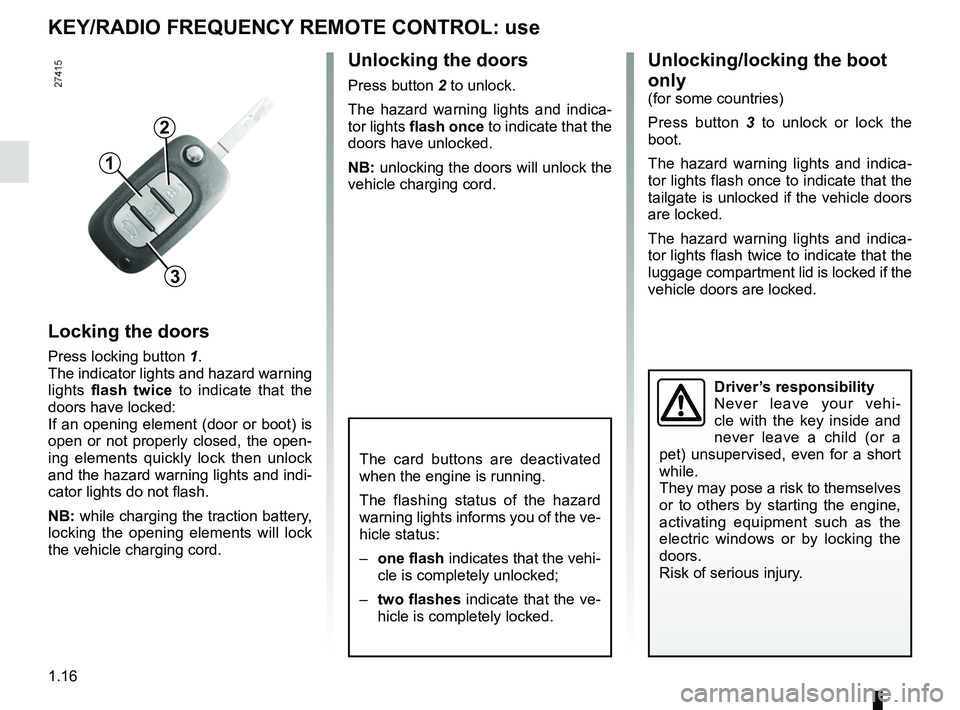
keys ...................................................... (up to the end of the DU)
locking the doors .................................. (up to the end of the DU)
1.16
ENG_UD21528_3
Télécommande à radiofréquence : utilisation (L38 - X38 - Re\
nault)
ENG_NU_914-4_L38e_Renault_1
Unlocking the doors
Press button 2 to unlock.
The hazard warning lights and indica -
tor lights flash once to indicate that the
doors have unlocked.
NB: unlocking the doors will unlock the
vehicle charging cord.
KeY/rADiO FreqUeNcY remOte cONtrOl: use
locking the doors
Press locking button 1.
The indicator lights and hazard warning
lights flash twice to indicate that the
doors have locked:
If an opening element (door or boot) is
open or not properly closed, the open -
ing elements quickly lock then unlock
and the hazard warning lights and indi -
cator lights do not flash.
NB: while charging the traction battery,
locking the opening elements will lock
the vehicle charging cord.
3
1
2
Unlocking/locking the boot
only
(for some countries)
Press button 3 to unlock or lock the
boot.
The hazard warning lights and indica -
tor lights flash once to indicate that the
tailgate is unlocked if the vehicle doors
are locked.
The hazard warning lights and indica -
tor lights flash twice to indicate that the
luggage compartment lid is locked if the
vehicle doors are locked.
Driver’s responsibility
Never leave your vehi -
cle with the key inside and
never leave a child (or a
pet) unsupervised, even for a short
while.
They may pose a risk to themselves
or to others by starting the engine,
activating equipment such as the
electric windows or by locking the
doors.
Risk of serious injury.
The card buttons are deactivated
when the engine is running.
The flashing status of the hazard
warning lights informs you of the ve-
hicle status:
– one flash indicates that the vehi-
cle is completely unlocked;
– two flashes indicate that the ve-
hicle is completely locked.
Page 23 of 195
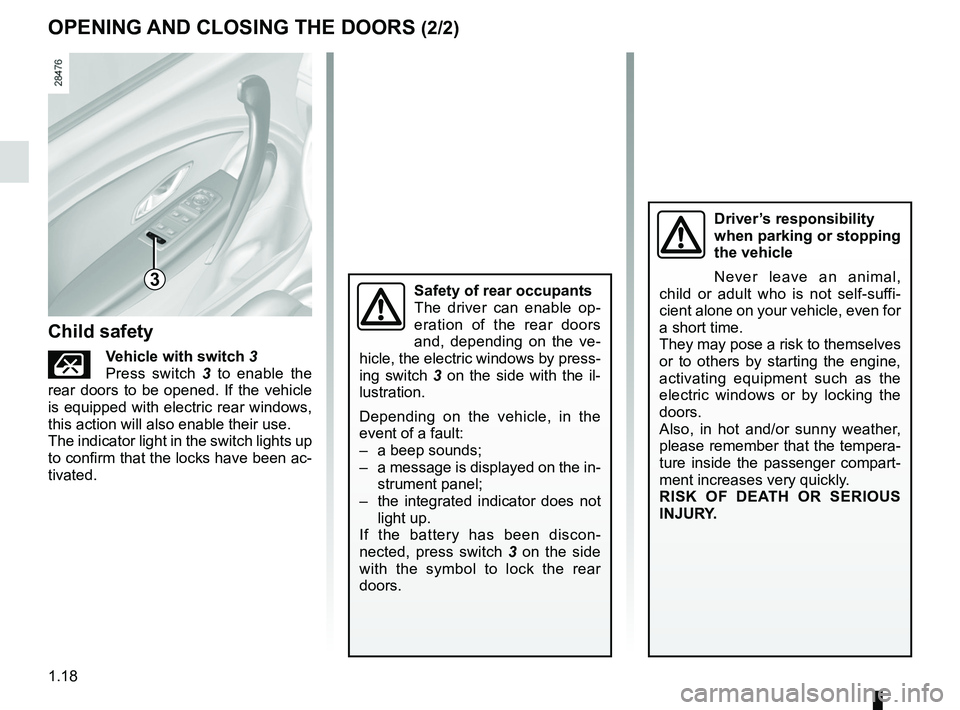
1.18
ENG_UD20061_2
Ouverture et fermeture des portes (L38 - X38 - Renault)
ENG_NU_914-4_L38e_Renault_1
OPeNiNg AND clOSiNg the DOOrS (2/2)
Driver’s responsibility
when parking or stopping
the vehicle
Never leave an animal,
child or adult who is not self-suffi -
cient alone on your vehicle, even for
a short time.
They may pose a risk to themselves
or to others by starting the engine,
activating equipment such as the
electric windows or by locking the
doors.
Also, in hot and/or sunny weather,
please remember that the tempera-
ture inside the passenger compart-
ment increases very quickly.
ri SK OF D eAth Or S eri OUS
iNJUr Y.
child safety
Çvehicle with switch 3
Press switch 3 to enable the
rear doors to be opened. If the vehicle
is equipped with electric rear windows,
this action will also enable their use.
The indicator light in the switch lights up
to confirm that the locks have been ac-
tivated.
Safety of rear occupants
The driver can enable op -
eration of the rear doors
and, depending on the ve -
hicle, the electric windows by press-
ing switch 3 on the side with the il-
lustration.
Depending on the vehicle, in the
event of a fault:
– a beep sounds;
– a message is displayed on the in-
strument panel;
– the integrated indicator does not
light up.
If the battery has been discon -
nected, press switch 3 on the side
with the symbol to lock the rear
doors.3
Page 39 of 195

air bag................................................... (up to the end of the DU)
additional methods of restraint side protection ................................ (up to the end of the DU)
methods of restraint in addition to the seat belts
(up to the end of the DU)
seat belts .............................................. (up to the end of the DU)
air bag ................................................... (up to the end of the DU)
side protection devices ......................... (up to the end of the DU)
1.34
ENG_UD23936_2
Dispositifs de protection latérale (L38 - X38 - Renault)
ENG_NU_914-4_L38e_Renault_1
side protection
SiDe PrOtectiON DeviceS
Warnings concerning the side air bag
– Fitting seat covers: seats equipped with an air bag require covers
specifically designed for your vehicle. Contact an approved Dealer to find
out if these covers are available. The use of any covers other than those
designed for your vehicle (and including those designed for another vehicle)
may affect the operation of the air bags and reduce your protection.
– Do not place any accessories, objects or even pets between the seatback, the
door and the internal fittings. Do not cover the seatback with any items such as
clothes or accessories. This may prevent the air bag from operating correctly
or cause injury when the air bag is deployed.
– No work or modification whatsoever may be carried out on the seat or internal
fittings, except by qualified personnel from an approved dealer.
– The area between the rear bench seatback and the trim is the area of air bag
operation: no objects must be placed here.
Side air bags
These air bags are fitted to the front
seats and are activated at the sides of
the seats (door side) to protect the oc-
cupants in the event of a severe side
impact.
curtain air bags
These are air bags fitted along the sides
of the vehicle in the ceiling which trigger
along the front and rear side windows
to protect the passengers in case of a
severe side impact.
Depending on the vehicle, a mark -
ing on the windscreen informs you
of the presence of additional means
of restraint (airbags, pretensioners,
etc.) in the passenger compartment.
Page 42 of 195
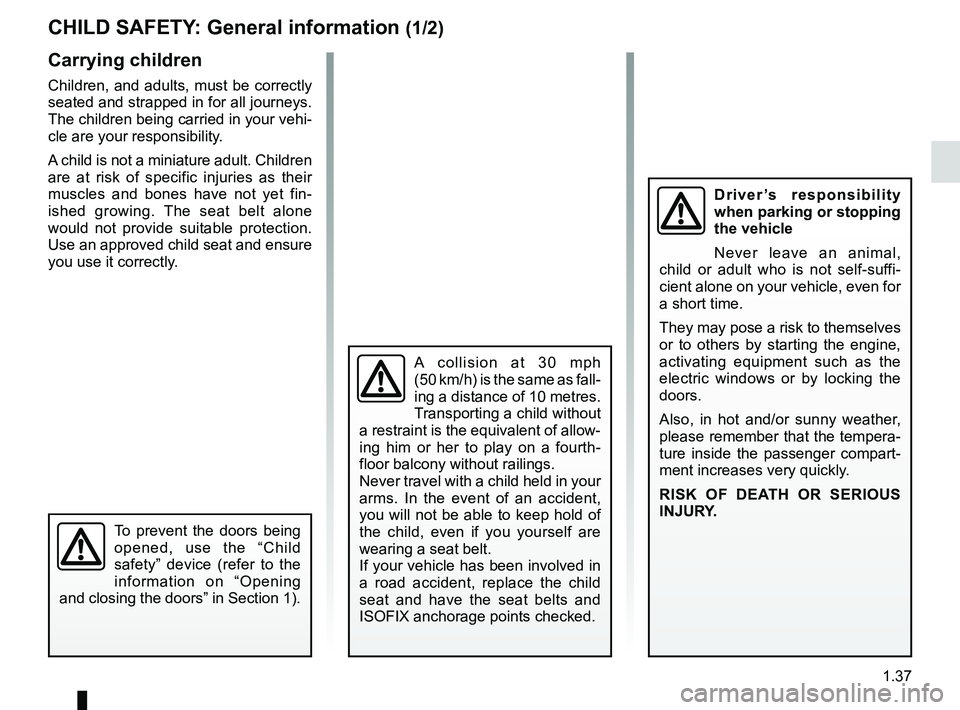
child safety............................................ (up to the end of the DU)
child restraint/seat ................................ (up to the end of the DU)
child restraint/seat ................................ (up to the end of the DU)
child restraint/seat ................................ (up to the end of the DU)
child seats ............................................. (up to the end of the DU)
transporting children ............................. (up to the end of the DU)
children ................................................. (up to the end of the DU)
1.37
ENG_UD21916_3
Sécurité enfants : généralités (X35 - L35 - X45 - H45 - \
X65 - X81 - X85 - X83 - B95 - D95 - K95 - J95 - R95 - L38 - X38 - X32 - \
Renault)
ENG_NU_914-4_L38e_Renault_1
Child safety: general information
chilD SAFetY : general information (1/2)
carrying children
Children, and adults, must be correctly
seated and strapped in for all journeys.
The children being carried in your vehi-
cle are your responsibility.
A child is not a miniature adult. Children
are at risk of specific injuries as their
muscles and bones have not yet fin -
ished growing. The seat belt alone
would not provide suitable protection.
Use an approved child seat and ensure
you use it correctly.
A collision at 30 mph
(50 km/h) is the same as fall-
ing a distance of 10 metres.
Transporting a child without
a restraint is the equivalent of allow-
ing him or her to play on a fourth -
floor balcony without railings.
Never travel with a child held in your
arms. In the event of an accident,
you will not be able to keep hold of
the child, even if you yourself are
wearing a seat belt.
If your vehicle has been involved in
a road accident, replace the child
seat and have the seat belts and
ISOFIX anchorage points checked.
To prevent the doors being
opened, use the “Child
safety” device (refer to the
information on “Opening
and closing the doors” in Section 1).
D r i v e r ’s r e s p o n s i b i l i t y
when parking or stopping
the vehicle
Never leave an animal,
child or adult who is not self-suffi -
cient alone on your vehicle, even for
a short time.
They may pose a risk to themselves
or to others by starting the engine,
activating equipment such as the
electric windows or by locking the
doors.
Also, in hot and/or sunny weather,
please remember that the tempera-
ture inside the passenger compart-
ment increases very quickly.
ri SK OF D eAth Or S eri OUS
iNJUr Y.
Page 43 of 195
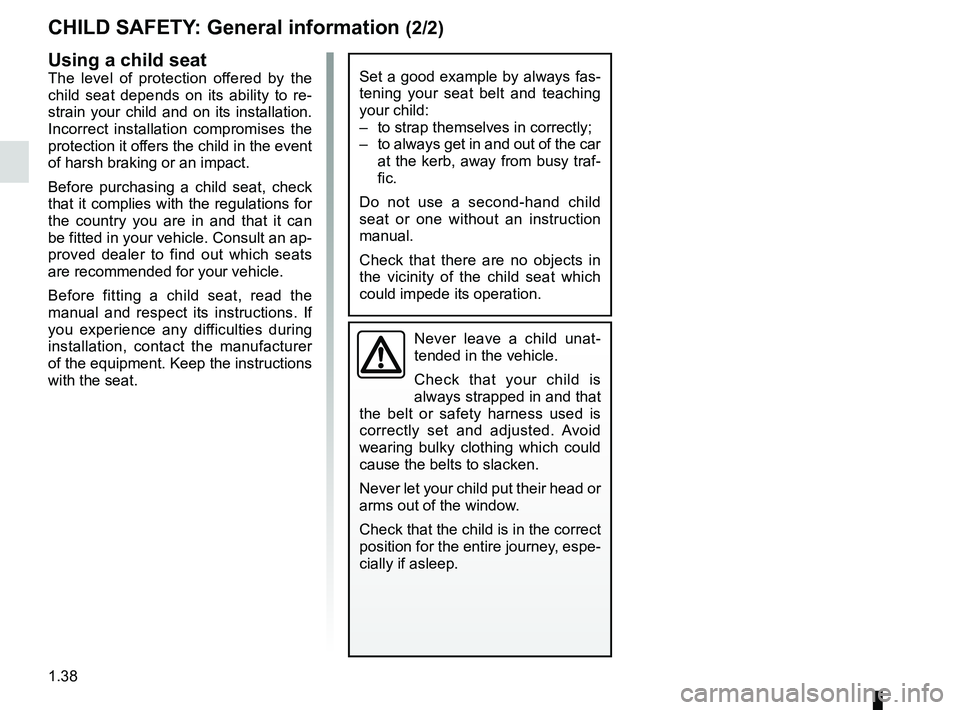
1.38
ENG_UD21916_3
Sécurité enfants : généralités (X35 - L35 - X45 - H45 - \
X65 - X81 - X85 - X83 - B95 - D95 - K95 - J95 - R95 - L38 - X38 - X32 - \
Renault)
ENG_NU_914-4_L38e_Renault_1
chilD SAFetY : general information (2/2)
Using a child seat
The level of protection offered by the
child seat depends on its ability to re -
strain your child and on its installation.
Incorrect installation compromises the
protection it offers the child in the event
of harsh braking or an impact.
Before purchasing a child seat, check
that it complies with the regulations for
the country you are in and that it can
be fitted in your vehicle. Consult an ap-
proved dealer to find out which seats
are recommended for your vehicle.
Before fitting a child seat, read the
manual and respect its instructions. If
you experience any difficulties during
installation, contact the manufacturer
of the equipment. Keep the instructions
with the seat.Set a good example by always fas-
tening your seat belt and teaching
your child:
– to strap themselves in correctly;
– to always get in and out of the car
at the kerb, away from busy traf-
fic.
Do not use a second-hand child
seat or one without an instruction
manual.
Check that there are no objects in
the vicinity of the child seat which
could impede its operation.
Never leave a child unat -
tended in the vehicle.
Check that your child is
always strapped in and that
the belt or safety harness used is
correctly set and adjusted. Avoid
wearing bulky clothing which could
cause the belts to slacken.
Never let your child put their head or
arms out of the window.
Check that the child is in the correct
position for the entire journey, espe-
cially if asleep.
Page 45 of 195

towing rings .......................................... (up to the end of the DU)
child restraint/seat ................................ (up to the end of the DU)
child restraint/seat ................................ (up to the end of the DU)
child safety ............................................ (up to the end of the DU)
child seats ............................................. (up to the end of the DU)
child restraint/seat ................................ (up to the end of the DU)
transporting children ............................. (up to the end of the DU)
1.40
ENG_UD23036_3
Sécurité enfants : choix de la fixation du siège enfant (L38 é\
lectrique - Renault)
ENG_NU_914-4_L38e_Renault_1
Jaune NoirNoir texte
Choosing a child seat mounting
chilD SAFetY : choosing a child/baby seat mounting (1/2)
There are two ways of attaching child
seats: via the seat belt or using the
ISOFIX system.
Attachment via the seat belt
The seat belt must be adjusted to
ensure that it is effective in the event of
harsh braking or an impact.
Ensure that the strap paths indicated
by the child seat manufacturer are re-
spected.
Always check that the seat belt is cor-
rectly fastened by pulling it up, then
pulling it out fully whilst pressing on the
child seat.
Check that the seat is correctly held by
moving it from side to side and back
to front: the seat should remain firmly
fixed.
Check that the child seat has not been
installed at an angle and that it is not
resting against a window. Attachment using the iSOFiX
system
Authorised ISOFIX child seats are ap
-
proved in accordance with regulation
ECE-R44 in one of the three following
scenarios:
– ISOFIX universal 3-point forwardfac-
ing seat
– ISOFIX semi-universal 2-point seat
– specific
For the latter two, check that your child
seat can be installed by consulting the
list of compatible vehicles.
Attach the child seat with the ISOFIX
locks, if these are provided. The ISOFIX
system allows quick, easy, safe fitting.
The ISOFIX system consists of 2 rings
and, in some cases, a third ring.
Before using an ISOFIX
child seat that you pur -
chased for another vehicle,
check that its installation is
authorised. Consult the list of ve -
hicles which can be fitted with the
seat from the equipment manufac -
turer.
No modifications may be
made to the component
parts of the restraint system
(ISOFIX seat belts, seats
and their mountings) originally fitted.
The seat belt must never
be twisted or the tension
relieved. Never pass the
shoulder strap under the
arm or behind the back.
Check that the seat belt has not
been damaged by sharp edges.
If the seat belt does not operate nor-
mally, it will not protect the child.
Consult an approved dealer. Do not
use this seat until the seat belt has
been repaired.
Do not use the child seat
if it may unfasten the seat
belt restraining it: the base
of the seat must not rest on
the buckle and/or catch of the seat
belt.
Page 56 of 195
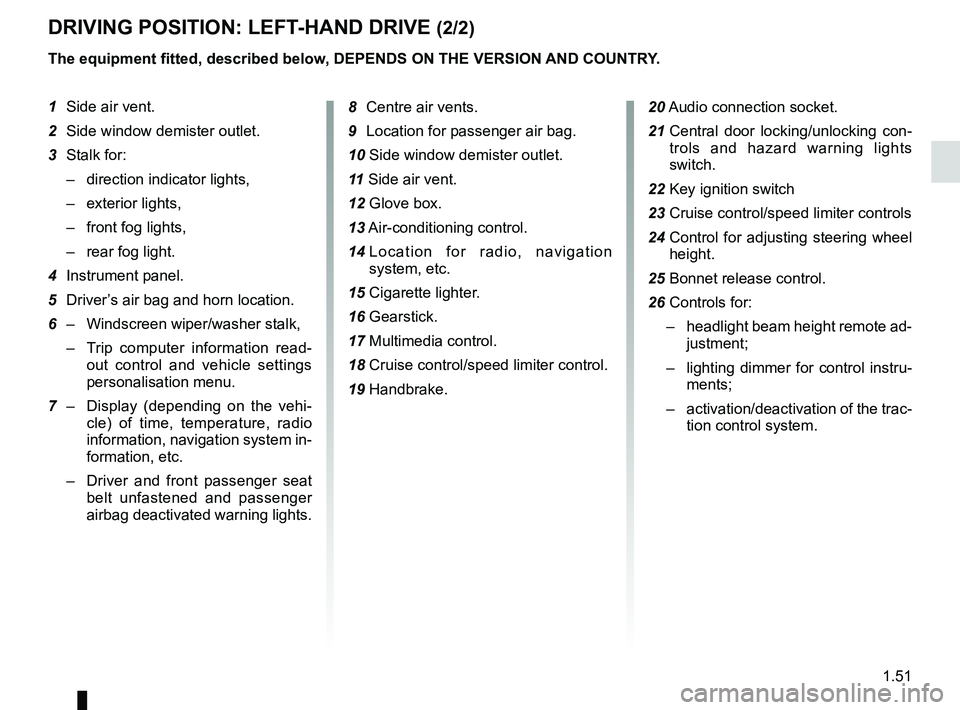
JauneNoirNoir texte
1.51
ENG_UD23033_2
Poste de conduite à gauche (L38 électrique - Renault)
ENG_NU_914-4_L38e_Renault_1
DriviNg POSitiON: leFt-hAND Drive (2/2)
the equipment fitted, described below, DePeNDS ON the verSiON AND cOUNtr Y.
1 Side air vent.
2 Side window demister outlet.
3 Stalk for:
– direction indicator lights,
– exterior lights,
– front fog lights,
– rear fog light.
4 Instrument panel.
5 Driver’s air bag and horn location.
6 – Windscreen wiper/washer stalk,
– Trip computer information read -
out control and vehicle settings
personalisation menu.
7 – Display (depending on the vehi -
cle) of time, temperature, radio
information, navigation system in-
formation, etc.
– Driver and front passenger seat
belt unfastened and passenger
airbag deactivated warning lights. 8
Centre air vents.
9 Location for passenger air bag.
10 Side window demister outlet.
11 Side air vent.
12 Glove box.
13 Air-conditioning control.
14 Location for radio, navigation
system, etc.
15 Cigarette lighter.
16 Gearstick.
17 Multimedia control.
18 Cruise control/speed limiter control.
19 Handbrake. 20
Audio connection socket.
21 Central door locking/unlocking con -
trols and hazard warning lights
switch.
22 Key ignition switch
23 Cruise control/speed limiter controls
24 Control for adjusting steering wheel
height.
25 Bonnet release control.
26 Controls for:
– headlight beam height remote ad-
justment;
– lighting dimmer for control instru-
ments;
– activation/deactivation of the trac-
tion control system.
Page 58 of 195
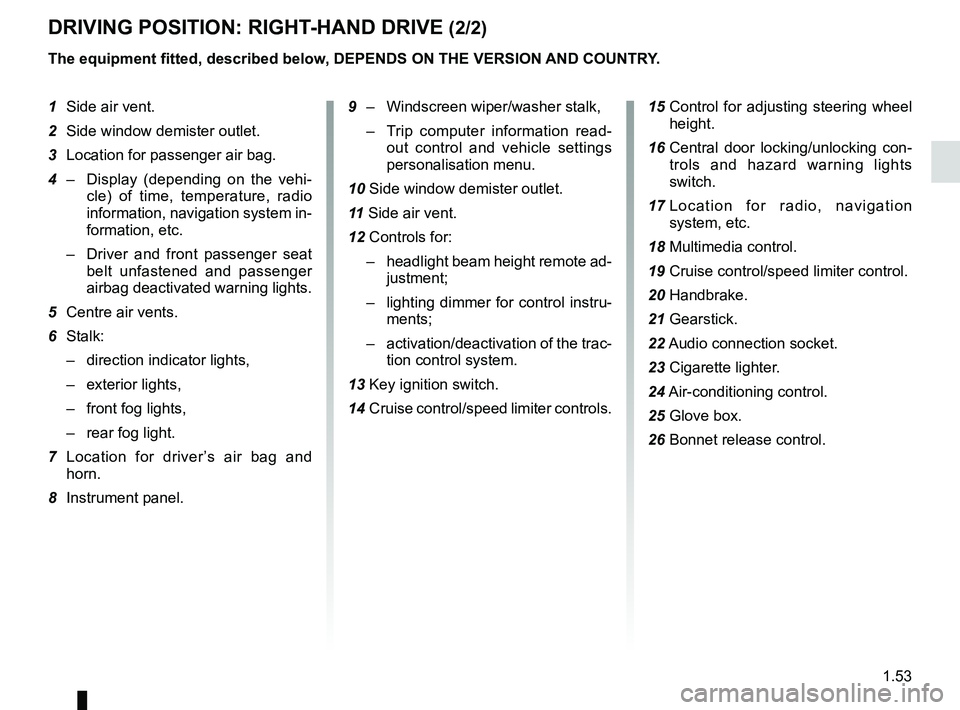
JauneNoirNoir texte
1.53
ENG_UD23034_2
Poste de conduite à droite (L38 électrique - Renault)
ENG_NU_914-4_L38e_Renault_1
DriviNg POSitiON: right-hAND Drive (2/2)
the equipment fitted, described below, DePeNDS ON the verSiON AND cOUNtr Y.
1 Side air vent.
2 Side window demister outlet.
3 Location for passenger air bag.
4 – Display (depending on the vehi -
cle) of time, temperature, radio
information, navigation system in-
formation, etc.
– Driver and front passenger seat
belt unfastened and passenger
airbag deactivated warning lights.
5 Centre air vents.
6 Stalk:
– direction indicator lights,
– exterior lights,
– front fog lights,
– rear fog light.
7 Location for driver ’s air bag and
horn.
8 Instrument panel.
9 – Windscreen wiper/washer stalk,
– Trip computer information read -
out control and vehicle settings
personalisation menu.
10 Side window demister outlet.
11 Side air vent.
12 Controls for:
– headlight beam height remote ad-
justment;
– lighting dimmer for control instru-
ments;
– activation/deactivation of the trac-
tion control system.
13 Key ignition switch.
14 Cruise control/speed limiter controls. 15
Control for adjusting steering wheel
height.
16 Central door locking/unlocking con -
trols and hazard warning lights
switch.
17 Location for radio, navigation
system, etc.
18 Multimedia control.
19 Cruise control/speed limiter control.
20 Handbrake.
21 Gearstick.
22 Audio connection socket.
23 Cigarette lighter.
24
Air-conditioning control.
25 Glove box.
26 Bonnet release control.
Page 83 of 195

starting .................................................. (up to the end of the DU)
starting the engine ................................ (up to the end of the DU)
driving ................................................... (up to the end of the DU)
starting the engine ................................ (up to the end of the DU)
stopping the engine .............................. (up to the end of the DU)
2.2
ENG_UD25305_4
Démarrage (L38 électrique - Renault)
ENG_NU_914-4_L38e_Renault_2
Starting, stopping the engine
Start position D
Starting the engine
– Move the gear lever to position P
only ;
– turn the key to position D and re -
lease it.
Warning light
Ṑ may flash on the in -
strument panel, along with a beep. As
soon as light
Ṑ stops flashing and
the beep stops, the vehicle is ready to
drive.
“Stop and steering lock”
position St
To unlock: turn the key and the steering
wheel slightly.
To lock: remove the key and turn the
steering wheel until the steering column
locks.
“Accessories” position AWhen the ignition is switched off, any
accessories (radio, etc.) will continue to
function.
“On” position MThe ignition is switched on:
St Arting, St OPPing the engine
Driver’s responsibility
Never leave your vehi -
cle with the key inside and
never leave a child (or a
pet) unsupervised, even for a short
while.
There is a risk that they could start
the engine or operate electrical
equipment (electric windows etc.)
and trap part of their body (neck,
arms, hands, etc.).
Risk of serious injury.
Never switch off the ignition before
the vehicle has stopped completely.
Once the engine has stopped, the
brake servo, power-assisted steer -
ing, etc., and the passive safety de-
vices such as the airbags and pre -
tensioners will no longer operate.
The vehicle can only be started if
the charging cord is unplugged from
the vehicle.
The vehicle can only be started if
the selection lever is at P. Please
see the information on “Gear con -
trol” in Section 2.
Stopping the engine
Bring the key to “Stop” position.
Warning light
Ṑ goes out.
Page 104 of 195

3.1
ENG_UD29438_4
Sommaire 3 (L38 - X38 - Renault)
ENG_NU_914-4_L38e_Renault_3
Section 3: Your comfort
Air vents. . . . . . . . . . . . . . . . . . . . . . . . . . . . . . . . . . . . \
. . . . . . . . . . . . . . . . . . . . . . . . . . . . . . . . . . . 3.2
Automatic climate control . . . . . . . . . . . . . . . . . . . . . . . . . . . . . . . . . . . . . . . . . . . . . . . . . . . . . . . . . 3.4
Air conditioning: programming . . . . . . . . . . . . . . . . . . . . . . . . . . . . . . . . . . . . . . . . . . . . . . . . . . . . . . 3.9
Air conditioning: information and advice on use . . . . . . . . . . . . . . . . . . . . . . . . . . . . . . . . . . . . . . . . 3.11
Electric windows . . . . . . . . . . . . . . . . . . . . . . . . . . . . . . . . . . . . . . . . . . . . . . . . . . . . . . . . . . . . . . . . 3.12
Interior lighting . . . . . . . . . . . . . . . . . . . . . . . . . . . . . . . . . . . . . . . . . . . . . . . . . . . . . . . . . . . . . . . . . . 3.14
Sun visor . . . . . . . . . . . . . . . . . . . . . . . . . . . . . . . . . . . . . . . . . . . . . . . . . . . . . . . . . . . . . . . . . . . . . . 3.15
Passenger compartment storage space and fittings . . . . . . . . . . . . . . . . . . . . . . . . . . . . . . . . . . . . . 3.16
Accessories socket . . . . . . . . . . . . . . . . . . . . . . . . . . . . . . . . . . . . . . . . . . . . . . . . . . . . . . . . . . . . . . 3.19
Ashtray – Cigarette lighter . . . . . . . . . . . . . . . . . . . . . . . . . . . . . . . . . . . . . . . . . . . . . . . . . . . . . . . . . 3.19
Luggage compartment . . . . . . . . . . . . . . . . . . . . . . . . . . . . . . . . . . . . \
. . . . . . . . . . . . . . . . . . . . . . . . 3.20
Roof bars . . . . . . . . . . . . . . . . . . . . . . . . . . . . . . . . . . . . . . . . . . . . . . . . . . . . . . . . . . . . . . . . . . . . . . 3.21
Multimedia equipment . . . . . . . . . . . . . . . . . . . . . . . . . . . . . . . . . . . . . . . . . . . . . . . . . . . . . . . . . . . . 3.22